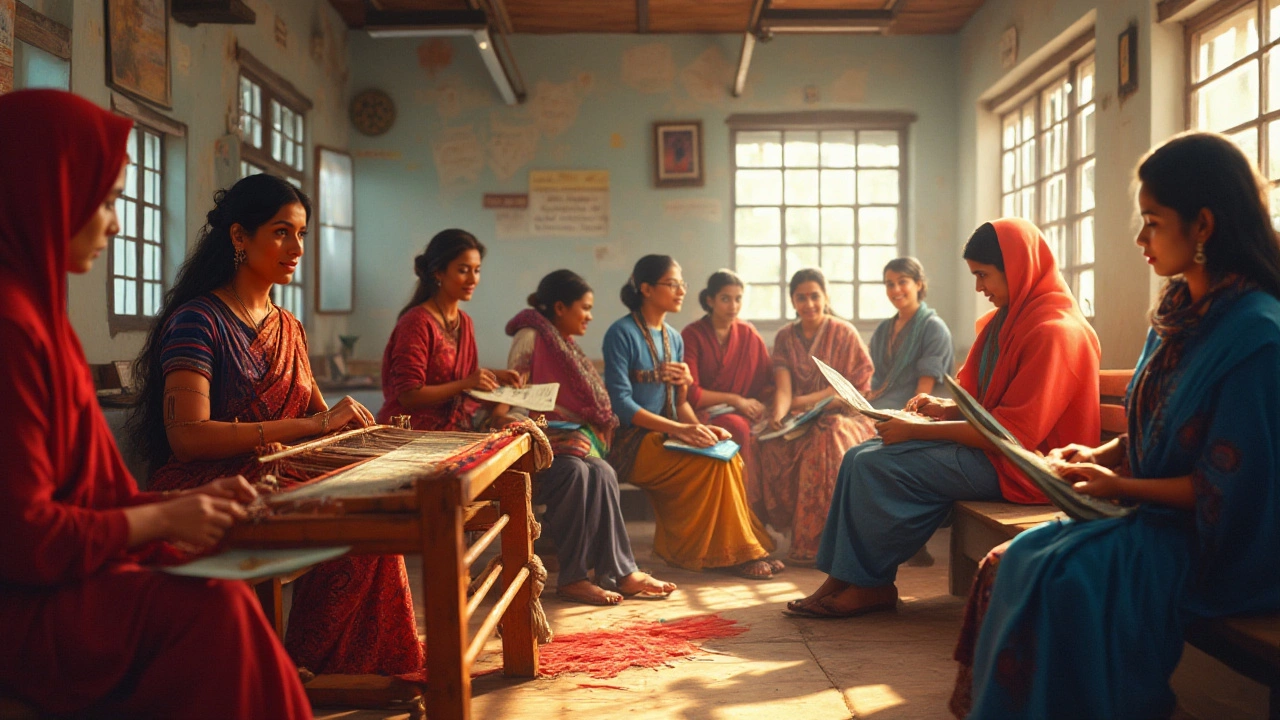In a world that thrives on diverse talents and skills, vocational activities shine as beacons of opportunity, especially for women. The age-old question of how to balance personal ambitions with societal roles finds an answer in the hands-on, practical nature of vocational training. But what exactly are vocational activities, and how can they be the key to unlocking new avenues for women?
Let's delve into this transformative realm where skills meet opportunity, empowering women to redefine their success, one skill at a time. From tailoring to tech workshops, vocational activities span a wide gamut, offering something for everyone. Their impact is not merely confined to economic benefits but extends to personal development and community involvement, making them an essential tool in modern society.
- Understanding Vocational Activities
- Tailoring Skills to Market Demands
- Empowerment through Community Engagement
- Tips for Pursuing Vocational Training
Understanding Vocational Activities
Vocational activities encompass a broad spectrum of engagements focused on honing specific skills, targeted towards practical and professional applications. These activities are designed to prepare individuals for specific trades, crafts, or careers, often eschewing traditional academic paths in favor of hands-on, applicable experiences.
The beauty of vocational training lies in its adaptability and relevance to current market demands. For women, especially, these activities offer a unique pathway to empowerment and financial independence. According to a report by the International Labour Organization, vocational training can increase employment opportunities by up to 70%, a significant step towards economic self-sufficiency.
"Vocational activities are not just about acquiring a skill. They are about empowering individuals to succeed in fields where they can make significant contributions," says Marie Kondo, a leading advocate for skill-based education.
At its core, vocational activities differ from conventional education by emphasizing practical skills over theoretical knowledge. They entail a variety of fields ranging from culinary arts and fashion design to more technical areas like information technology and automotive repair.
Historical Context and Modern Evolution
The origins of vocational training can be traced back to ancient guilds where apprentices learned their trade under the tutelage of experienced craftsmen. Today, far from the dusty workshops of yore, these activities have expanded into modern classrooms and online platforms, democratizing access for women globally.
The Role of Vocational Training in Women's Lives
For women, vocational activities mean more than just skill acquisition—they represent an opportunity to break barriers. As gender dynamics shift across cultures, vocational training has emerged as a powerful tool to bridge gender gaps in the workforce.
Consider Anjali, a young woman from a rural Indian village, who transformed her life through a tailoring program. She not only supports her family financially but also inspires other women in her community to pursue their ambitions. This ripple effect is evident globally, whereby women who engage in vocational training pass on their knowledge, creating supportive networks.
This approach to education emphasizes practical skills and real-world applications, making it an appealing alternative for many. With growing recognition of its value, governments and organizations are increasingly investing in vocational programs, ensuring they are tailored to meet the needs of today's fast-evolving job market.
Key Benefits of Vocational Activities
- Immediate Employability: Participants are often ready for the workforce upon completion of their training.
- Increased Accessibility: Many programs are short-term and offer flexible schedules, making them more accessible for women with family responsibilities.
- Networking Opportunities: Being part of a vocational program connects women with industry professionals and peers, fostering future collaboration.
By understanding and investing in vocational activities, women can better navigate, and even reshape, the workforce landscape. This, in turn, contributes to a more diverse and equitable economy.
Tailoring Skills to Market Demands
The world is ever-evolving, and job markets are in a state of constant flux. To thrive, vocational activities for women must be aligned with current market demands. This ensures not just employment, but empowerment, allowing women to compete effectively in today's competitive landscape.
Understanding Market Trends
The first step in tailoring skills involves understanding market trends. With industries such as technology, healthcare, and sustainability on the rise, there are abundant opportunities for women to capitalize on. According to recent studies, the demand for tech-savvy professionals has grown by 20% in the last year alone, making skills in coding, digital marketing, and IT highly sought after.
Identifying In-Demand Skills
Identifying the right skill set is crucial. For example, in the technology sector, the following skills are trending:
- Coding and Programming: With around 50% of businesses citing coding expertise as a top requirement.
- Cybersecurity: The global increase in digital threats has heightened the demand for cybersecurity professionals.
- Data Analysis: Companies seek experts to interpret complex data to drive decision-making processes.
Bridging the Gap through Vocational Training
Vocational training programs are instrumental in bridging the gap between market needs and the skill sets of women. Tailored programs focus on practical, hands-on learning experiences, making them incredibly effective. They often feature collaborations with industry leaders, providing insights into real-world applications.
For instance, programs like Women Who Code and Girls in Tech focus on offering specialized training tailored to meet the industry's dynamic needs, empowering participants to contribute meaningfully in the marketplace.
The Role of Technology
Technological advancements have also revolutionized how vocational training for women occurs. Online platforms like Coursera and LinkedIn Learning provide access to cutting-edge courses globally, making skill acquisition in various fields more accessible than ever before.
Looking to the Future
As market demands continue to evolve, so must the scope and depth of vocational activities. Keeping an eye on emerging trends, such as green technologies and artificial intelligence, will be vital for maintaining the relevance and competitiveness of women's skills in the workforce.
By tailoring their skillsets to meet market needs, women not only fortify their own economic independence but also contribute significantly to broader societal growth. In an increasingly interconnected world, the value of such vocational training cannot be overstated.

Empowerment through Community Engagement
At the heart of vocational activities lies a powerful catalyst: community engagement. When women are given the opportunity to participate in skill-building endeavors, they not only hone their abilities but also galvanize a collective spirit that uplifts entire neighborhoods. This is where the real magic happens, as skills acquired are multiplied through shared experiences and mutual support.
Building Networks of Support
The importance of networks cannot be overstated in the realm of vocational training. As women come together to learn, they form bonds that transcend the classroom. These networks serve as support systems, offering everything from emotional encouragement to professional referrals. For instance, women who train together in culinary arts might later collaborate to start a community kitchen, multiplying their impact manifold.
Success Stories from Around the World
Consider the case of the SEWA (Self-Employed Women's Association) in India. This association provides vocational training to over a million women, covering areas such as embroidery, agriculture, and various crafts. The result? Enhanced job prospects and improved livelihoods for entire families. Similarly, organizations in Kenya have transformed the vocational landscape by offering training in renewable energy fields, thereby addressing both poverty and sustainability.
- India: SEWA supports over a million women with diverse vocational training programs.
- Kenya: Vocational forestry programs encourage income from sustainable practices.
- Brazil: Community weaving projects resonate with cultural heritage while providing income.
Feedback and Continuous Improvement
Community engagement offers a unique advantage: feedback. When women gather to share their experiences, they provide invaluable insights into the training process, allowing programs to evolve and address real-world challenges efficiently. This cyclic nature of feedback and improvement ensures that vocational activities remain relevant and impactful.
In essence, community engagement amplifies the empowerment vocational activities bring. It transforms individual skill growth into a larger movement, fostering not only personal development but also societal progress.
Tips for Pursuing Vocational Training
Embarking on a journey of vocational activities can be a transformative phase, especially for women seeking to carve a niche in today’s dynamic economy. Selecting the right path and making the most of vocational training requires a strategic approach. Here’s a roadmap to get you started.
Identify Your Interests
The first step is understanding what excites you. Are you drawn to creative fields like graphic design, or do technical areas like coding pique your interest? Choosing a vocational training course aligned with your passions ensures you remain motivated and engaged.
Research Market Demands
While personal interest is critical, aligning it with market demand is essential. Investigate job market trends and identify skills that are in high demand. For instance, as the world moves increasingly digital, skills like digital marketing and data analysis are experiencing a surge in popularity.
Connect with Mentors
Having a mentor can be invaluable as you navigate your training. Seek individuals who have established themselves in your area of interest. They can provide insights from their experience, advise on best practices, and help you avoid common pitfalls.
Engage in Continuous Learning
Vocational training doesn’t stop when the course ends. Embrace a mindset of lifelong learning by staying updated with advancements in your field. Online platforms offer numerous free and paid resources to keep your skills fresh and relevant.
Utilize Networking Opportunities
Networking is an often-underestimated tool in vocational fields. Attend industry-specific seminars, workshops, and webinars to connect with peers and industry leaders. Building a strong network can lead to internship opportunities and job offers.
Leverage Financial Assistance Programs
Did you know many governments and NGOs offer scholarships and funding programs for women engaging in these vocational pursuits? Don’t hesitate to apply for assistance, as these resources can alleviate financial burdens and allow you to focus on learning.
Incorporating these tips into your approach ensures your journey in vocational training is not only successful but also enjoyable. With the right strategies in place, women empowerment through skillful endeavors can truly become a reality.
